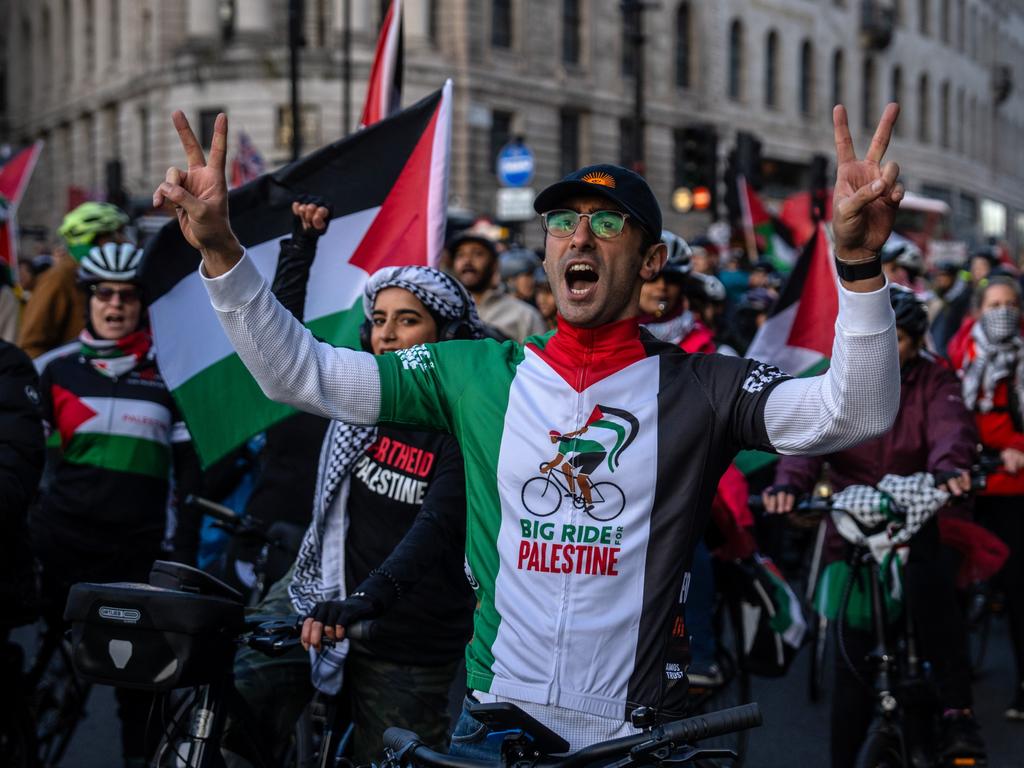Israel fights a war in Gaza, and another in the court of public opinion
With up to 11,000 civilians killed in Gaza so far in the six-week conflict, Israel is under unprecedented pressure to show greater restraint in the manner in which it seeks to destroy Hamas.

Israel’s war on Hamas has entered its most dangerous phase, with a high-risk assault on Gaza’s biggest hospital being watched by the world as Israeli forces methodically dismantle the terror group tunnel by tunnel.
Israel increasingly is fighting two wars, one on the ground against the murderous Hamas and the other in the court of international opinion as it tries not to alienate its allies by military overreach that would contribute further to the already huge civilian death toll in Gaza.
This difficult balancing act was writ large in Israel’s decision this week to raid Gaza’s largest hospital complex, the al-Shifa, housing about 2300 hospital patients, staff and displaced families.
The assault was Israel’s boldest move yet in its war on Hamas, driven by the conviction – backed by US intelligence assessments – that the terror group had a command and control centre under the hospital and was using the patients and doctors as human shields, which is a war crime.
But Israel could not afford, morally or politically, to strike the hospital from the air or charge in with guns blazing given the growing alarm among Israel’s allies, including the US and Australia, about the already excessive civilian death toll so far in the conflict.
With up to 11,000 civilians killed in Gaza so far in the six-week conflict, Israel is under unprecedented pressure to show greater restraint in the manner in which it seeks to destroy Hamas.

So Israel Defence Forces troops moved into the hospital complex room by room in a slow-motion precision assault that, at the time of writing, did not lead to the death of patients or doctors and resulted in the occupation of at least some of the large al-Shifa complex.
“It was something that was very, very focused and we went in a very sort of cautious way into the hospital,” IDF spokesman Lt Col Richard Hecht says.
But only a few steps behind the Israeli soldiers were Israeli military cameramen, documenting the Hamas guns found on the site. The Israelis also filmed the medical supplies they brought to the stricken hospital, which had almost shut down because of a lack of fuel, medicine, food and water. The careful documentation of events was aimed at countering Hamas claims that it did not use the hospital for military purposes and any assault on the facility would be a heinous war crime.
In the first 48 hours after the raid Israeli troops had released videos of a small amount of weapons and a room it said was used as a control centre by Hamas. The search continued but it was initially an underwhelming amount of evidence to suggest the hospital was a key Hamas command centre, as had been claimed.
However, every discovery of weapons was beamed to the world almost immediately by Israel’s sophisticated military public relations apparatus. It underlines the fact Israel’s war against Hamas is increasingly an information war, with Israel fighting to counter the narratives of the terror group that seeks at every turn to portray Israel’s offensive as one of reckless indifference to civilian lives.
“Both sides are working so hard on the media portrayal of the conflict because the more attention that civilian casualties get, the more that will weaken political sentiment among politicians who have, to some extent, to default to their domestic public opinion,” says Hagai M. Segal, a Middle East expert and commentator from New York University in London, who visited Australia this week.
“The media war has been as important as the physical war since the beginning of this conflict because holding on to external hearts and minds is so central to the progress of the fight on the ground.”
So far, the West has remained steadfast in its support for Israel’s right to defend itself by destroying Hamas in Gaza in the wake of the terrorist organisation’s massacre of 1200 Israelis on October 7. That is unlikely to change.
But with each passing week the political tolerance for more civilian deaths in Gaza is waning, making Israel’s push for a military victory against Hamas more complicated. French President Emmanuel Macron has called for an end to Israel’s bombing and this week Canadian Prime Minister Justin Trudeau called on Israel to stop the “killing of women, of children, of babies” in Gaza. EU foreign affairs chief Josep Borrell this week urged Israel not to be “consumed by rage” in its response to the October 7 massacre.
Even Israel’s staunchest ally, the US, has stepped up pressure on Israel to take a more targeted approach to its war against Hamas, with US Secretary of State Antony Blinken saying this week that “far too many Palestinians have been killed” in the conflict.
Joe Biden bluntly warned Israel that hospitals “must be protected” and the White House made it clear before the raid on al-Shifa that any airstrike on the hospital would be unacceptable. Biden’s growing caution reflects turning public opinion in the US, where a new Marist/NPR/PBS NewsHour poll found the percentage of Americans who believe Israel’s attacks on Gaza have been “too much” has jumped from 26 per cent to 36 per cent in four weeks.
In Australia the conflict appears to be tying the Labor Party in knots, with Anthony Albanese refusing to fully back Foreign Minister Penny Wong’s surprise support for a ceasefire in Gaza. The government is caught between its stated support for Israel’s right to defend itself by eliminating Hamas and its growing revulsion at the civilian death toll.
Wong’s call to move towards a ceasefire has raised more questions than it has answered and suggests the government’s position on the conflict is far from settled. Wong does not say what sort of ceasefire she advocates. Should it be for one week, or one month, or permanent? If it is permanent, how can Australia support Israel’s right to destroy Hamas while calling for an end to the hostilities required to achieve that aim?
And what about Biden and Israeli Prime Minister Benjamin Netanyahu’s argument that any ceasefire only would allow Hamas fighters to regroup and thereby lengthen the likely conflict and contribute to Israeli and civilian casualties?
Wong has not enunciated exactly what she wants or explained what the practical benefits would be, beyond the existing daily humanitarian pauses of about four hours that Israel has instituted to let civilians trapped in the battle zone of north Gaza move to safer areas in southern Gaza.
Netanyahu says any ceasefire, or longer pause in fighting, would be agreed only in return for some of the 240 Israeli hostages being held by Hamas in Gaza.
At the time of writing, Hamas reportedly had agreed to a proposal to free 50 women and child hostages in return for a three to five-day pause “in place” in fighting, increased humanitarian aid and the release of an unspecified number of Palestinian women and children held in Israeli prisons.
Even if this comes off, it seems highly unlikely that Hamas would agree to release all hostages because their presence greatly complicates Israel’s military options as it tries to destroy the terror group.
Segal says Israel is being judged more harshly by the international community because of what he calls a “kneejerk default towards the Palestinian cause”. “This is not how the world responded to civilian deaths in many other conflicts, such as the conflict in Yemen or against the Tamils in Sri Lanka,” he says. “Could you imagine a couple of months into America’s campaign in Afghanistan (after the September 11 terror attacks on the US) people saying that ‘too many Afghan civilians have died. Oh, well, we’re out of here?’ ”
Although Israel has paid close attention to the public relations side of its assault on the al-Shifa hospital, it shows no signs of slowing its ground assault in north Gaza. On the contrary, the pace of the military advances has surprised many experts. Israeli forces now control most of northwestern Gaza and this week stormed key institutions of the Hamas-run government including the parliament building, police headquarters and other government buildings.
Israeli troops have taken control of the Shati refugee camps and continue to encircle Hamas forces in the centre of Gaza City.
The military says it has found weapons and Hamas fighters throughout northern Gaza, in private homes, government buildings and schools. It points to its incursion into al-Shifa hospital as an example of its determination to flush out Hamas wherever it hides.
“There is no place in Gaza we won’t reach,” Netanyahu says. “There’s no hiding, no shelter, no refuge for Hamas murderers … The hostages will be released and Hamas will be destroyed.”
Israeli Defence Minister Yoav Gallant says “in northern Gaza, Hamas has lost control”. He claims Israeli forces now control “the above-ground area” in north Gaza. But they have not yet dislodged Hamas from the honeycomb-like network of tunnels running underneath Gaza City.
The Israeli leadership is looking to extend the ground war into southern Gaza, which has been hit during Israel’s month-long aerial bombardment but less heavily than the north, where the bulk of Hamas forces are thought to be. Leaflets have been dropped warning people to leave several southern cities in Gaza.

Gallant says the ground operation eventually will “include both the north and south. We will strike Hamas wherever it is.” Although southern Gaza is less urban than the north, a ground conflict there will be complicated by the presence of an estimated 1.5 million people, many of whom are displaced, having moved south at the urging of Israel to escape the battle in the north.
A ground war in the south potentially will spread Israeli forces more thinly than Netanyahu may like as large numbers of troops are being kept in Israel’s north in case of an attack by Iran-backed Hezbollah forces in southern Lebanon.
Hezbollah and Israeli forces have exchanged missile, rocket and gunfire almost every day since October 7, but so far Hezbollah has given no indication it wants a broader conflict with Israel.
Israel also is having to contend with growing unrest in the West Bank, where its security forces have been unable, or in many cases unwilling, to prevent violent attacks on Palestinians by armed far-right settlers living in settlements in the West Bank.
Regional tensions also remain high. This week a US Navy destroyer shot down a drone that came from Yemen and is suspected to have been launched by the Iran-backed Houthi militia. Sporadic attacks by Iran-backed militia on US troops in Iraq and Syria have led the US to rush naval forces, troops and air-defence systems to the region.
Under pressure from the international community and aware it is being blamed for the humanitarian crisis in Gaza, Israel finally is taking more significant steps to increase the flow of aid into southern Gaza, especially food, medicine and water.
Israel has lifted the cap on the number of aid trucks entering Gaza from Egypt in the south and this week the number of trucks entering Gaza was more than 100 a day, substantially higher than in previous weeks but still far short of what will be required to alleviate the humanitarian crisis.
It also has partially lifted its ban on fuel entering Gaza by approving 24,000 litres of diesel fuel for UN aid distribution. Israel cut off food, water, medicine and fuel to Gaza in a fit of fury after October 7 and only slowly has approved the resumption of humanitarian aid into Gaza through the Rafah crossing in southern Gaza.
Segal says the West needs to better understand Israel’s determination and its mindset in the wake of the October 7 massacre by Hamas. “The Israelis are acutely aware of what can happen when they launch a military campaign that they believe has to end in a decisive outcome and it doesn’t,” he says. “Their absolute nightmare scenario would be that Hamas is not defeated and it continues to exist and has the capacity to fire rockets at Israel.
“I don’t think we can underestimate how much the Israelis really feel about this. In a kind of Holocaust narrative, it’s the sense that Jews were totally unprotected (on October 7) when people (Hamas) who believed that killing Jews was their ideology rampaged through their communities. I don’t think we can underestimate the scale to which this has affected the Israeli national mindset. It really was the Israeli 9/11.”
Segal says despite the West’s concern about the large civilian death toll in Gaza, Israel’s allies ultimately will stand with Israel, not least because to do otherwise would send a disastrous message to other jihadist terror groups around the world.
“The Americans, the British and the Australians know all too well that this might be today’s fight for Israel, but it might be something bigger going forward,” he says. “So I think there is a reticence to shut the Israelis down the minute there is an uncomfortable dynamic around the civilian impact. There is a fear that this would only embolden extremist jihadist organisations in other geographies.
“This really is a huge issue for Western governments in what is an increasingly chaotic geopolitical picture around the world.”






To join the conversation, please log in. Don't have an account? Register
Join the conversation, you are commenting as Logout